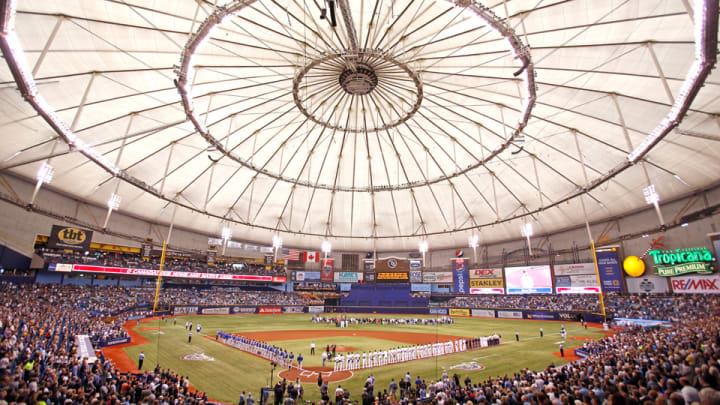Ballpark Quirks: Catwalks and rays abound at Tampa's Tropicana Field

Tropicana Field has a lot of unique claims. It is the only MLB ballpark with a fixed roof, the only one with catwalks that obstruct the field of play, the only one with natural dirt base paths combined with artificial turf, and the only one to have live cownose rays located in the stadium. That last one doesn't have much competition, though.
Take what you want from those "only" statements, but Tropicana Field certainly has quirks.
Opened in St. Petersburg in 1990 as Florida Suncoast Dome, the venue attempted to draw MLB to the Tampa Bay area for years, finally welcoming the then-Devil Rays in 1996.
From the start, Tropicana's cable-supported domed roof — the second largest in the world, behind the Georgia Dome — offered six acres of translucent, Teflon-coated fiberglass. Opposing forces of tension and compression keep the roof supported. But a design that allows for a grand, eight-story-high rotunda entrance — said to be designed from the very blueprints used for the rotunda at Ebbets Field — slant the roof 6.5 degrees, dropping from 225 feet above second base to 85 feet at the centerfield wall.
The slanted roof not only helped cut construction and cooling costs and protected from high winds, but also created some quirks with a series of four catwalks above the playing surface. Labeled A, B, C and D, the lowest ring, the D ring, drops to as close as 59 feet above the field of play. And each ring has different ground rules. If a ball strikes the higher A or B ring, it is in play, no matter what the carom does to the ball. Hitting the C or D ring in play gets you a home run.
If the roof's quirkiness weren't enough for an otherwise drab concrete-laden Tropicana Field, in 2006, the Rays added a 10,000-gallon ray tank in a partnership with the Florida Aquarium. The 35-foot tank, one of the 10 largest in the nation, welcomes up to 50 fans at a time in a free attraction that allows visitors to touch and feed the 30 rays at their location behind the rightfield fence.
While Tropicana Field won't ever make the top half of any list of the best ballparks in MLB, the quirkiness factors at The Trop will always rank high.
